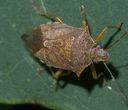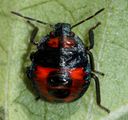Podisus
Podisus
Classification
- Phylum: Arthropoda
- Subphylum: Hexapoda
- Class: Insecta
- Order: Hemiptera
- Suborder: Heteroptera
- Infraorder: Pentatomomorpha
- Superfamily: Pentatomoidea
- Family: Pentatomidae
- Subfamily: Asopinae
- Genus: Podisus
Pronunciation
How to pronounce Podisus: /poˈdiː.sus/
These audio files are automatically generated. While they are not always 100% accurate, they are a good starting point.
Images






Summary
Podisus is a genus of predatory stink bugs beneficial for pest control, with at least 20 described species. They are notable for their distinctive spines and predatory habits, primarily targeting larval insects.
Physical Characteristics
Members of the genus Podisus, commonly known as Spined Soldier Bugs, exhibit a characteristic spined appearance, which distinguishes them from other stink bugs.
Identification Tips
Look for the spines on the pronotum and the typical shape of the body, which is somewhat flattened. Coloration may vary, but they often have a brown or green hue.
Habitat
Primarily found in neotropical regions, with some species adapted to various habitats including grasslands and gardens.
Distribution
Widespread in the Neotropical region; in the U.S., 4 species are common, with P. sagitta found in southern Florida and Texas, and P. neglectus restricted to the eastern states.
Diet
Podisus species are predatory, primarily feeding on various arthropods, especially larval Lepidoptera (caterpillars) and Coleoptera (beetles).
Life Cycle
The life cycle includes egg, nymphal stages (with multiple instars), and adult stages, with significant development occurring during nymphal instars.
Reproduction
Eggs are laid by females, generally in clusters, and the nymphs undergo several molts before reaching adulthood.
Predators
Information on specific predators is limited, but they may face predation from larger insects, birds, and other natural enemies.
Ecosystem Role
Predators of pest species, contributing to biological control within their habitats.
Economic Impact
P. maculiventris, a common species, is commercially marketed as a pest control agent in gardens and agricultural settings.
Collecting Methods
- Netting from plants
- Trapping using pheromones
Preservation Methods
- Ethanol preservation
- Pinning specimens
Similar Taxa
Misconceptions
Some may confuse them with harmful stink bugs; however, they are beneficial as predators.
Tags
- Pentatomidae
- Predatory Insect
- Biological Control
- Stink Bug